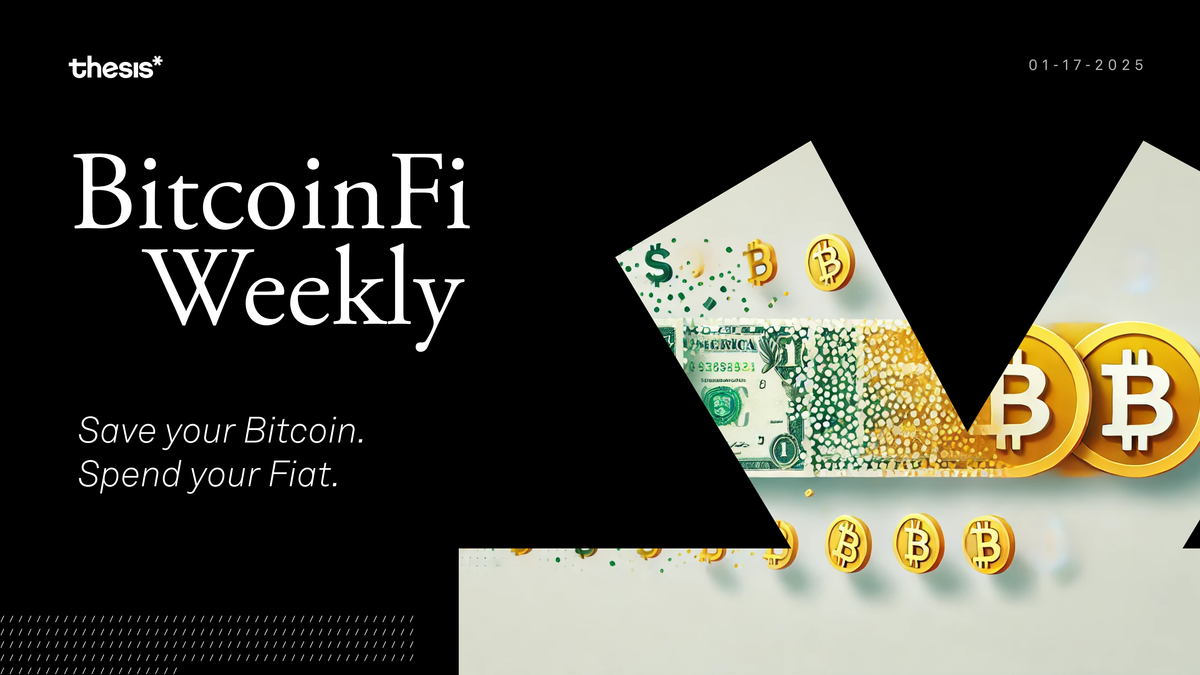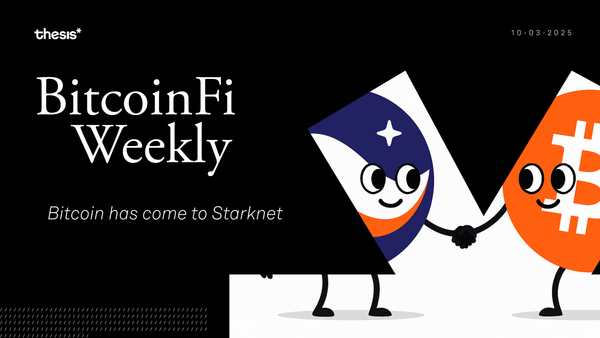Save your Bitcoin. Spend your Fiat.
As we explore the future of finance, it’s vital to remember why many people fell in love with Bitcoin: self-sovereignty, open access, and a genuine rejection of the old guard’s control.

Welcome to BitcoinFi Weekly. We cover where people use their BTC and what is changing in the Bitcoin world.
The race to build Bitcoin infrastructure in 2025 increasingly resembles the early days of the internet - a tension between open protocols and walled gardens. Building new financial systems demands fresh architecture - not repackaging traditional models that centralize control in the hands of the few. If we are to build on top of Bitcoin, we must incorporate its decentralized ethos. When we chase swift remedies through centralized routes, we risk compromising the very liberty that defines us. The work ahead of us demands our fidelity to decentralization and our steadfast belief that all should share prosperity. Welcome to BitcoinFi Weekly.
Here’s this week’s rundown:
₿ Feature Piece: 2025 is the Year of Bitcoin-backed Loans
🆔 Onchain digital identity comes to Bitcoin
📈 FBTC See-Saws
⚡ BRC2.0: The BRC20 Makeover
Feature Piece: 2025 is the Year of Bitcoin-backed Loans
Bitcoin-backed loans are rewriting the narrative for a generation of investors who have grown weary of steep tax bills and fear missing out on Bitcoin’s long-term growth. Picture a longtime Bitcoiner who wants to buy a house. In the past, they would have sold some Bitcoin, triggered a tax event, and probably kicked themselves later if the price soared. With Bitcoin-backed loans, that scenario changes drastically. Instead of selling, they post a portion of their Bitcoin as collateral and borrow the dollars they need—no taxable sale, no sell pressure, no stomach-churning anxiety...at least in theory.
But like all things that sound too good to be true, the devil lurks in the details. The current landscape resembles the early days of mortgage lending – before standardization when each bank wrote its own rules and borrowers paid whatever rate the market would bear. Compare it to those early days of the Grayscale Bitcoin Trust, when fees loomed high, and there was little competition. That’s where Bitcoin-backed loans stand now. They carry heavy rates and less flexible terms, so everyday Bitcoin holders see them as more of a curiosity than a solution.
Currently, the market is dominated by centralized players like Coinbase, offering products that feel more like reverse mortgages than traditional loans. Coinbase’s latest product, for instance, collateralizes loans with cbBTC. That’s a wrapper pegged to Bitcoin but administered entirely by Coinbase. Additionally, there’s a ~10% floating rate loan with no monthly payments – sounds innovative until you realize your Bitcoin isn't really your Bitcoin anymore. It's wrapped in their proprietary token, controlled by their systems, and subject to their rules. If you’re comfortable with Coinbase’s solvency, that may not bother you. Others see it as a step away from Bitcoin’s original premise. The similarities to a reverse mortgage are striking and deliberate. Both products target asset-rich, cash-poor individuals. Both allow borrowers to access liquidity without regular payments. Both accumulate debt silently in the background, like a python slowly constricting its prey.
Some innovators, like Lava.xyz, aim to bring this entire process closer to what many would consider “native” to Bitcoin, though they’re still a fraction of the total market. Ideally, we have a system that can merge self-custody and onchain loans. To maintain decentralized ideals, protocols must be built on Bitcoin native rails, like tBTC. tBTC uses a probabilistic process to select signers who collectively hold the BTC, so a malicious majority can’t suddenly seize funds already bridged. This design aims to reduce reliance on any single intermediary and keep funds more accessible. With on-chain proof of reserves, tBTC lets anyone check what’s backing the token. That contrasts with centralized wrappers like wBTC/cbBTC, which lean on external attestations. If large volumes of Bitcoin flow toward systems like tBTC, the ecosystem will shift away from centralized intermediaries.
Only a sliver of Bitcoin holders currently use these loan products, and fewer still pursue the “onchain” versions. But the mechanics are in place. Borrowers appear eager for rates that reflect real competition, and lenders are grappling with regulatory and custody concerns. Once the mainstream banks find a comfortable framework, you’ll see a wave of products that look more like traditional mortgages or auto loans, only backed by BTC.
BitcoinFi Updates
Onchain digital identity comes to Bitcoin
BLIFE Protocol has introduced its BLIFE.ID platform, marking Bitcoin's first on-chain digital identity system following their successful $7M funding round led by UTXO Management in December. The platform integrates several key features, including ordinal soft-staking with self-custody, social engagement mechanics, and seasonal leaderboard competitions, all while maintaining user anonymity. The system operates across three distinct layers: a foundation layer built on Bitcoin's network, a supportive layer facilitating token interactions, and an application layer hosting the broader Web3 ecosystem, with the $BLIFE token serving as the connecting thread throughout the protocol's architecture.
The protocol's token distribution structure reveals significant allocation towards community engagement, with 26.8% designated for community distribution and 56% allocated to liquidity provisions. The membership system implements a tiered structure ranging from Genesis to Node passes, each requiring varying levels of contribution and stake in the ecosystem. Notably, the protocol introduces a "Value-nomics" concept through its Proof of Valuable Work (PoVW) mechanism, which aims to align economic incentives with tangible ecosystem contributions, marking a departure from traditional blockchain reward systems.
While BLIFE's attempt to create a comprehensive digital identity system on Bitcoin presents an ambitious vision for ecosystem unification, its success will largely depend on whether its complex tokenomics and membership structure can maintain sufficient decentralization while delivering practical utility to users.
FBTC See-Saws
Fidelity’s FBTC volume surged with $463.08 million in Bitcoin inflows on January 15, its largest single-day intake since March 2024. This surge coincided with a broader rebound for spot Bitcoin ETFs in the United States, which collectively reclaimed $755.01 million after enduring four consecutive days of net outflows totaling $1.2 billion.
Days earlier, however, Fidelity’s FBTC also witnessed a record-breaking outflow that saw hundreds of millions leave both Bitcoin and Ethereum ETFs. It’s important to remember that not all crypto ETFs return the same output. While ETFs such as FBTC may offer convenience and passive exposure, long-term holders could bear considerable fee erosion compared to directly owning Bitcoin. Read more about this in Thesis’s State of Bitcoin 2024 Report.
BRC2.0: The BRC20 Makeover
Best in Slot and the Layer 1 Foundation have announced plans to launch BRC2.0, a significant upgrade to the BRC20 protocol, on testnet in Q1 2025. The "BRC20 Programmable Module," aims to introduce native smart contract functionality to BRC20 tokens on Bitcoin, enabling advanced features like DeFi applications, real-world asset tokenization, DAOs, and stablecoins without relying on external solutions. Following the testnet phase, the mainnet implementation is targeted for Q3 2025.
The development roadmap includes comprehensive technical infrastructure, with plans to release an open-source indexer (opindexer), complete documentation, testing suites, and developer tools. Additionally, OKX and Unisat Wallet are collaboratively developing an open-source BRC20 swap module.
Closing Thoughts
As we push deeper into the future of finance, it’s vital to remember why many of us fell in love with Bitcoin in the first place: self-sovereignty, open access, and a genuine rejection of the old guard’s control. Sure, there might be a shortcut if you slap a token onto centralized infrastructure, but that erodes the advantage of a trustless system, undermining Bitcoin’s core promise. By weaving decentralization into every layer, from custody to consensus, we ensure that our work actually furthers the mission of financial independence.
If there's a topic you’d like us to cover or have questions, reach out at [email protected].
Learn more about Mezo at the following channels:
👾 Discord: https://discord.mezo.org
🕊 X: https://twitter.com/MezoNetwork
🖥 Website: https://mezo.org
🏦 Deposit Portal: https://mezo.org/hodl
ℹ️ Docs: https://info.mezo.org





